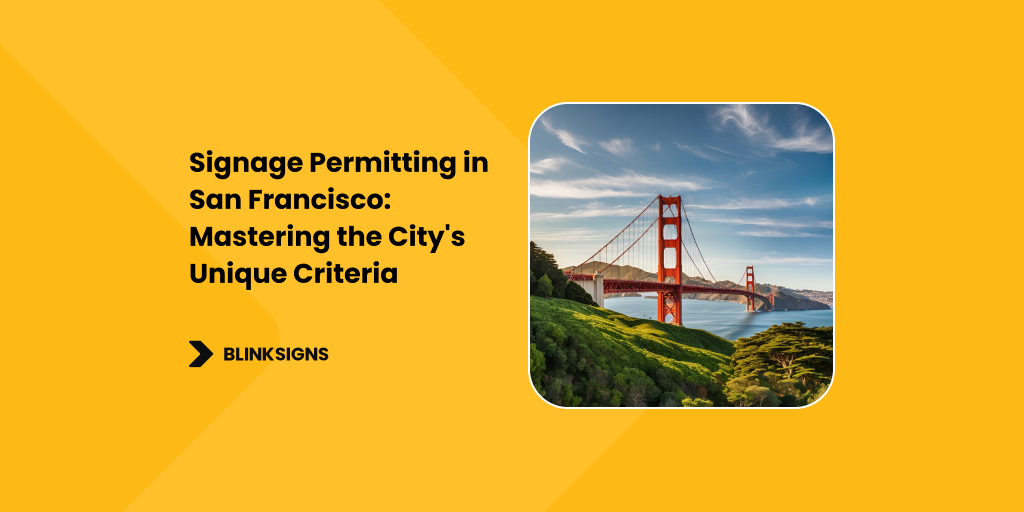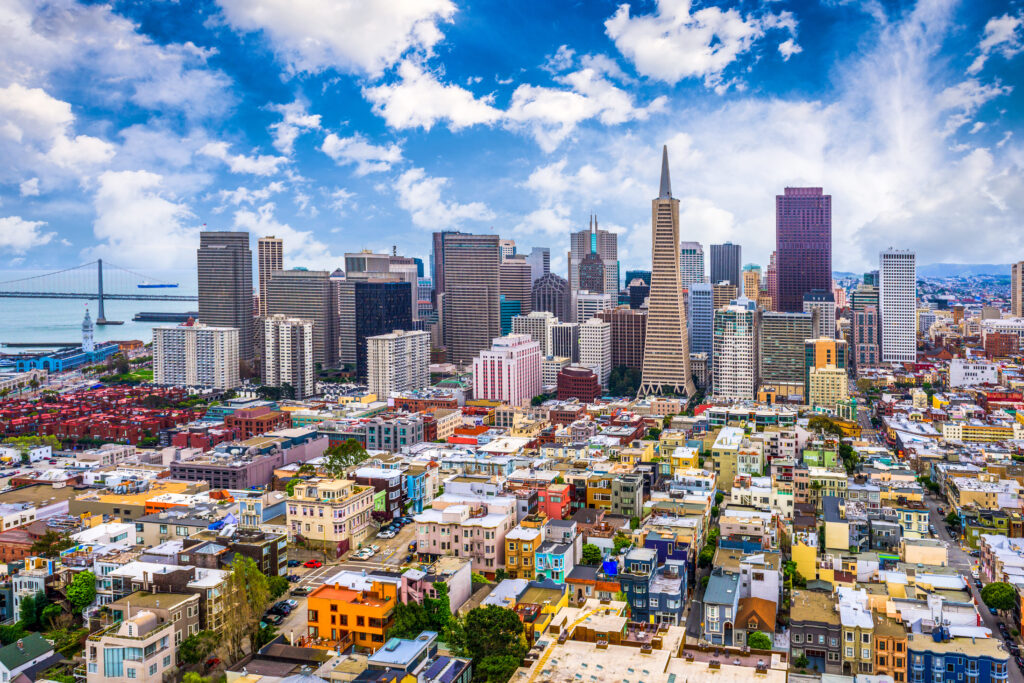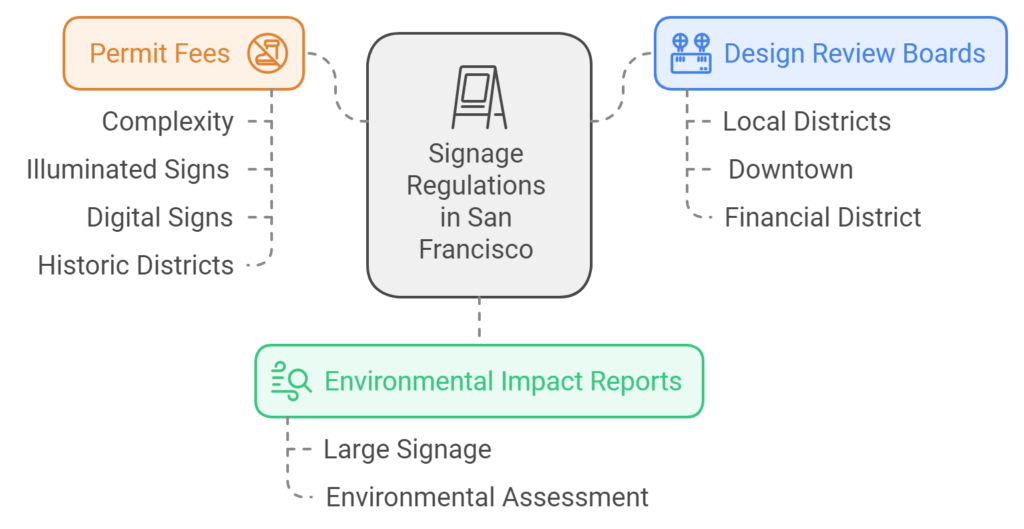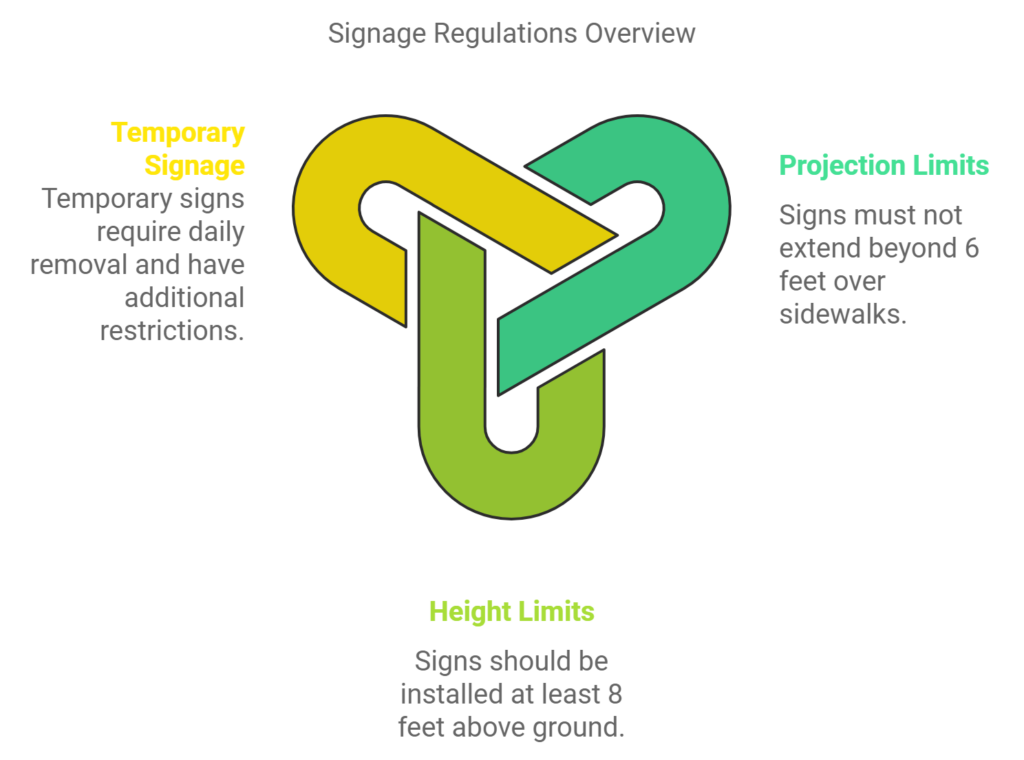
Signage Permitting in San Francisco: Mastering the City’s Unique Criteria
San Francisco’s signage permitting process is one of the most intricate in California due to the city’s diverse landscape, historic neighborhoods, and environmental sensitivity. To secure approval for signage, businesses must navigate a web of local regulations, environmental laws, and neighborhood-specific criteria. These unique regulations protect the city’s character, ensure ecological responsibility, and preserve historical aesthetics.
In this article, we’ll examine San Francisco’s specific signage permitting requirements and offer insights into how businesses can comply with the city’s distinctive standards.

san francisco california usa skyline
The Role of the San Francisco Planning Department in Signage Approvals
The San Francisco Planning Department is the primary authority for all signage applications within the city. Every proposed sign, whether temporary or permanent, must pass through this department for approval. The process involves ensuring the signage adheres to the city’s design standards, zoning laws, and environmental regulations.
For businesses in historic areas, such as Fisherman’s Wharf or North Beach, the Historic Preservation Commission adds another layer of scrutiny. They assess whether new signage maintains the area’s historic and aesthetic integrity. This could involve approving or rejecting materials, colors, and overall design based on whether they align with the district’s historical architecture.
Key Aspects:
- Environmental Impact Reports (EIR): In some cases, the Planning Department requires an EIR to assess the environmental impact of large signage.
- Design Review Boards: Certain districts in San Francisco have local design review boards that evaluate the appearance and placement of signs, particularly in Downtown or Financial District areas.
- Permit Fees: San Francisco’s permitting process involves permit fees that differ based on the complexity of the sign, whether it’s illuminated, digital, or installed in a historic district.

Signage Regulations in San Francisco chart
Understanding the approval process is critical to ensuring that signage meets all legal, environmental, and design requirements before installation.
Neighborhood-Specific Restrictions: Challenges and Considerations
San Francisco’s neighborhoods each come with their own identity, culture, and, most importantly, signage restrictions. For instance, the Chinatown district requires businesses to reflect its rich cultural heritage through traditional design elements. Vertical and intricate signage is encouraged, while flashy, modern designs are typically discouraged.
The Mission District, known for its colorful murals and artistic flair, allows for vibrant signage but restricts illuminated or digital signs to maintain the neighborhood’s bohemian feel. Businesses in areas like Castro—known for its iconic LGBTQ+ history—must comply with specific rainbow-themed signage requirements and local restrictions on light pollution.
In contrast, Haight-Ashbury demands signage that reflects its 1960s counterculture vibe. Neon lights and modern materials are limited, favoring vintage looks that align with the neighborhood’s historic architecture.
Key Neighborhoods:
- Chinatown: Encourages traditional, vertical signage with cultural motifs.
- Mission District: Promotes mural-style signage but restricts digital or illuminated options.
- Haight-Ashbury: Limits modern materials in favor of retro, historical designs.
- Castro: Signage must blend with the colorful LGBTQ+ heritage of the area.
Businesses looking to install signage in San Francisco must tailor their designs to match the specific cultural and historical identity of the neighborhood in which they operate. These neighborhood-specific restrictions can heavily influence the design and functionality of proposed signs.
Environmental Considerations: Coastal and Park Proximity
San Francisco’s commitment to environmental sustainability directly affects signage, especially for businesses near coastal areas or parks. The California Coastal Act imposes specific regulations on signage near coastal zones like Crissy Field or Ocean Beach. These regulations aim to protect coastal views, prevent light pollution, and ensure the use of sustainable materials.
For example, businesses in coastal zones must avoid brightly illuminated signs, which can disrupt marine life and disturb nearby residential areas. Similarly, parks like Golden Gate Park impose strict requirements on signage materials, limiting non-biodegradable plastics and promoting eco-friendly alternatives such as wood, aluminum, or recycled materials.
Environmental Impact:
- Energy-efficient LED signage is favored in environmentally sensitive areas to reduce power consumption.
- Recyclable materials: Businesses are encouraged to use recyclable or biodegradable materials, particularly in signage near parks or natural reserves.
- Wildlife Impact Studies: Some signage projects near environmental zones may require a wildlife impact study to ensure they do not disturb local ecosystems.
Businesses should also consider installing solar-powered signage in eco-sensitive areas, as this aligns with San Francisco’s sustainability goals and reduces environmental impact.
Digital Signage Regulations: Navigating Restrictions on LED and Billboards
San Francisco has some of the country’s strictest regulations on digital signage. These regulations are primarily intended to preserve the city’s aesthetic integrity and prevent visual clutter, particularly in residential areas and historic districts. The Outdoor Advertising Act governs many restrictions, limiting new billboards and LED signage in most city areas.
Digital signage is allowed in commercial zones like Union Square but must comply with specific size, brightness, and frequency of content changes. The city also regulates flashing lights and rotating billboards, especially in areas where traffic or pedestrian safety could be compromised.
Key Regulations:
- Size and Brightness Limits: Digital signs in commercial zones must not exceed specified dimensions, and brightness must be adjustable depending on the time of day.
- Content Duration: Dynamic signage must display content for a minimum duration (often 10-15 seconds) before transitioning to prevent excessive distractions.
- Historical District Prohibitions: To preserve the city’s historic charm, digital billboards are prohibited in areas like Alamo Square and Fisherman’s Wharf.
San Francisco businesses must carefully assess the allowable zones for digital signage, which is often restricted to commercial districts with specific limitations on size, brightness, and frequency of display changes.
Historic Preservation Areas: Balancing Tradition and Modernity
San Francisco has many historic districts, each with distinct signage regulations. In areas like North Beach, Alamo Square, and Telegraph Hill, signage must comply with local zoning laws and align with the architectural aesthetics of the surrounding historic buildings.
Businesses in these areas often need approval from the Historic Preservation Commission, which ensures that signage materials, colors, and lighting remain in harmony with the district’s historical character. For example, neon or LED signs are usually prohibited in favor of traditional wood or metal signage that complements Victorian and Edwardian building styles.
Historical Considerations:
- Non-digital signage: Traditional signage materials like painted wood or ironwork are preferred in historic areas to maintain the district’s integrity.
- Colors and Typography: Businesses must use period-appropriate color schemes and fonts to fit within the neighborhood’s historical context.
- Lighting Restrictions: Bright lights or flashing digital signs are generally prohibited in historic areas to preserve the serene atmosphere.
For businesses in these districts, obtaining a Certificate of Appropriateness is often required to ensure the sign blends with the surrounding historic architecture.
Zoning Laws and Conditional Use Permits: Understanding the Complexities
San Francisco’s zoning laws are among the most complex in California. They govern where and how signage can be installed. Businesses in mixed-use zones, such as SoMa or Mission Bay, must comply with residential and commercial zoning requirements, which may restrict their signage’s size, height, or illumination.
In some instances, businesses must apply for a Conditional Use Permit (CUP) if their signage does not meet existing zoning regulations. For example, suppose a company wishes to install an illuminated sign in a predominantly residential area. In that case, they may need to obtain a CUP and demonstrate that the signage will not negatively impact residents.
Key Points:
- Commercial Zoning: Allows more prominent, illuminated signs but may require additional review based on local aesthetic standards.
- Residential Zoning: Often restricts signage to more minor, non-illuminated signs to avoid disturbing nearby homes.
- Conditional Use Authorization: Necessary when signage exceeds zoning limits or is installed in mixed-use areas.
Businesses must carefully review San Francisco’s zoning map and consult with experts to ensure compliance with local laws, as zoning requirements can vary significantly between neighborhoods.
Sign Size, Height, and Illumination Limits: Keeping it in Proportion
Signage size, height, and illumination limits are strictly enforced in San Francisco, especially in commercial hubs like Union Square and SoMa. Businesses must ensure that their signs meet the city’s guidelines on proportions and illumination levels, especially when installing illuminated signs near residential buildings.
In many cases, height restrictions prevent signage from obscuring views of significant landmarks, while illumination limits help reduce light pollution. In areas like SoMa, signs may be allowed to extend taller than in other parts of the city, but businesses must still adhere to overall limits set by the Planning Department.
Key Considerations:
- View Corridor Preservation: In areas like Union Square, signs must not block views of iconic landmarks or public spaces.
- Illumination Levels: Brightness levels for illuminated signs must be controlled to avoid disturbing residents, particularly in mixed-use zones.
- Flashing Lights: Flashing or moving lights are generally prohibited in residential areas, even when the signs are installed in commercial districts.
Adhering to these guidelines ensured businesses avoided penalties or delays during the approval process and successfully secured signage permits.
Public Right-of-Way and Signage: Legal and Safety Requirements
San Francisco’s signage regulations extend to the public right-of-way, including signs that project over sidewalks or public spaces, such as blade signs, awning signs, and sandwich boards. These signs must comply with specific height and projection limits to ensure they do not obstruct pedestrian traffic or pose safety hazards.
To install signage over public spaces, businesses must secure a Public Works permit from the Planning Department in addition to their regular signage permit. This ensures that the sign will not encroach on the sidewalk or public areas and meets all legal safety standards.

Signage regulations overview chart
Key Restrictions:
- Projection Limits: Signs projecting over sidewalks must not extend beyond a specific limit, usually set at around 6 feet, depending on the area.
- Height Limits: Signs must be installed at a height that does not interfere with pedestrians or cause safety issues, typically no lower than 8 feet above ground.
- Temporary Signage: Temporary signs, like sandwich boards, are subject to additional restrictions and often require daily removal.
By complying with these safety and legal guidelines, businesses can enhance their visibility without disrupting the flow of foot traffic or risking fines.
Permit Types and Timelines: Navigating the Approval Process
San Francisco offers various types of permits for business signage, each with different requirements and approval timelines. The most common permits include temporary signage permits for short-term promotions and permanent signage permits for long-term installations. Depending on the complexity and location of the sign, the approval process can range from a few weeks to several months.
For permanent signage, mainly digital or illuminated, businesses may need additional reviews from the San Francisco Planning Department and potentially the Historic Preservation Commission, adding time to the process. Meanwhile, temporary signage permits for event-based signs or promotional banners are typically quicker to secure but come with restrictions on size and placement.
-
Signage Permit Types and Timelines in San Francisco
| Permit Type | Description | Typical Requirements | Approval Timeline | Key Considerations |
| Permanent Sign Permit | For long-term signage installations, including illuminated, digital, or large-scale signage. | – Design plans
– Zoning approval – Environmental review (if applicable) – Compliance with city codes |
2 to 6 months | It requires additional review in historic districts and environmentally sensitive areas. Before installation, signs must meet all design, zoning, and environmental criteria. |
| Temporary Sign Permit | For short-term signage like banners, promotional signs, or event-based displays. | – Temporary design specs
– Event Timeline – Size and placement restrictions |
1 to 3 weeks | There are strict limits on sign size, height, and placement. Temporary signs cannot interfere with pedestrian traffic or public safety and must be removed promptly after the event. |
| Public Works Permit | For signs encroaching on public spaces, such as blade signs, awnings, or sandwich boards. | – Encroachment approval
– Sign dimensions and height – Pedestrian clearance checks |
1 to 2 months | Any signage that extends into public sidewalks or spaces requires permits. Pedestrian safety must be ensured, and obstructions of public walkways must be avoided. |
| Historic District Review | Additional review is required for signage in historically significant areas such as Alamo Square. | – Historic Preservation Commission approval
– Traditional materials – Design alignment with historic architecture |
4 to 8 months (depending on complexity) | Businesses must use historically appropriate materials and designs. To preserve aesthetic integrity, illuminated or digital signs are typically prohibited in historic areas. |
| Conditional Use Permit (CUP) | Required when signage exceeds zoning limits or is installed in mixed-use zones (e.g., SoMa). | – Zoning compliance review
– Public hearing (if applicable) – Community impact assessment |
3 to 6 months | CUPs are necessary for signage that does not meet standard zoning requirements. Must prove that signage will not negatively impact surrounding residential or commercial areas. |
| Environmental Review | For signs in environmentally sensitive zones, such as coastal areas or parks. | – Environmental Impact Report (EIR)
– Eco-friendly materials and design – Wildlife impact assessment |
Varies based on environmental impact | Required for signs near Golden Gate Park, Crissy Field, or other sensitive areas. Must demonstrate minimal environmental disruption, particularly in coastal zones. |
Businesses should prepare their applications well and account for delays to meet project deadlines.
Conclusion
San Francisco’s signage permitting process is multifaceted, with unique requirements based on zoning laws, environmental concerns, and neighborhood-specific guidelines. From ensuring compliance with the California Coastal Act to navigating the city’s zoning map, businesses must be meticulous in securing signage permits.
For those looking to navigate the complexities of signage permitting in San Francisco, BlinkSigns offers expert guidance to ensure that your business signage meets all regulatory requirements while making a lasting impact on your customers. Contact us today at Sales@blinksigns.com to get started on your next signage project, and let us help you master the intricate permitting process in San Francisco.